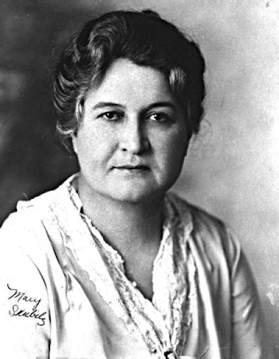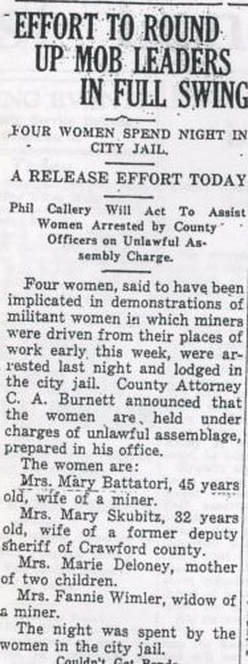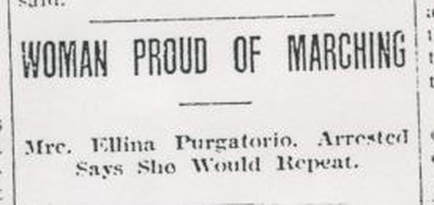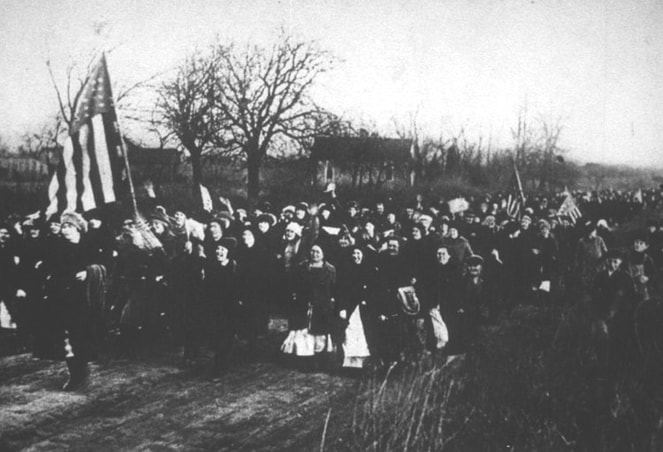|
Second grader LaVaun Smith heard a great uproar outside her school in southeast Kansas. She and the other students rushed to the door of their country school house to see the commotion. They threw open the door that cold December day in 1921, and a rowdy parade of women filled the road beating on dish pans, wash pans and metal buckets with sticks and kitchen utensils. A number of the students spotted their mothers as the women converged on the mine across the road to confront strike-breakers, who had taken their husbands' coal mining jobs. The school kids' dads had struck the mines in Crawford and Cherokee County three months prior, but companies kept operations running with non-union workers, and the sheriff arrested labor leaders for violating a statewide strike injunction. With a harsh winter on the horizen coming, wives, mothers, and sisters of the mine workers decided to take things into their own hands. Gathering before dawn, December 12, they marched through the region, routing "scabs" at 63 different mines. No fear One marcher recorded in her diary, the women “rolled down to the [mine] pits like balls and the men ran like deers....There was absolutely no fear in these women’s hearts.” The throng of marching women, some pregnant and others carrying small children, grew from two-thousand to possibly six-thousand. For three days they completely shut down coal production in the region.  One of the leaders, Mary Skubitz, had immigrated from Slovenia as a child. According to her son Joe, "Hunger drove most of those women. They just wanted something to eat and a house." Mary spoke German, Italian, and Slovene, which allowed her to rally a broad spectrum of women in the mining camps. Fluent in English as well, she was persuasive with the mine bosses and strikebreakers. Kansas Governor Henry Allen dispatched four companies of the Kansas National Guard, including a machine gun division to get the women back to their kitchens. The women, armed only with their pots, pans and red pepper spray, marched from mine to mine singing hymns and waving American flags.  The first day there was little violence, but the following two days when large numbers of men joined the protest, strikebreakers were beaten and property vandalized, inflaming headlines across the nation. The New York Times declared them an Amazon Army...on the warpath...invading mines and scattering workers with pepper spray. December 16, Sheriff Milt Gould arrested Mary and three other women, who spent one night in jail due a $750 bail. Over the following month, the sheriff and his deputies hoped to make massive arrests, bystanders would not cooperate in naming names, and women protesters told deputies they could not recall who had marched beside them. Deputies jailed 50-some men and women who participated in the action. And Crawford County District Judge Andrew Curran handed down fines to forty-nine protesters for disturbing the peace, unlawful assembly, and assault. The marching women were characterized by the newspapers in one of two ways. Benjamin W. Goossen write in Kansas History: A Journal of the Central Plains (Autumn 2011), "either it was a laughable “Petticoat March” of witless and misguided domestics, or the attack of a ferocious 'Amazon Army' that threatened to destroy traditional notions of women’s role in society."  The Wichita Beacon described them as “a few women, peeking from behind windows, sometimes waving handkerchiefs and sometimes ‘making eyes’ at the soldiers." The Kansas City Kansan labed them “women terrorists,” who “clawed and used teeth” like “tigresses.” Some of the women defended themselves in letters to the editors, and small groups of women continued to accost strikebreakers even after the strike was called off. The following election season, (this was just two years after American women got the vote) the women who had tested their strength marching turned their energy to campaigning against the men who'd opposed them. Both Sheriff Gould, who had arrested dozens of marchers and Judge Curran, who had sentenced them were ousted from office. Comments are closed.
|
I'm fascinated to discover little-known history, stories of people and events that provide a new perspective on why and how things happened, new voices that haven't been heard, insight into how the past brought us here today, and how it might guide us to a better future.
I also post here about my books and feature other authors and their books on compelling and important historical topics. Occasionally, I share what makes me happy, pictures of my garden, recipes I've made, events I've attended, people I've met. I'm always happy to hear from readers in the blog comments, by email or social media. Archives
September 2023
Categories
All
|

